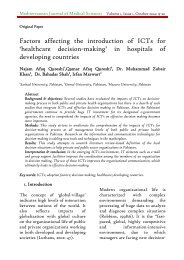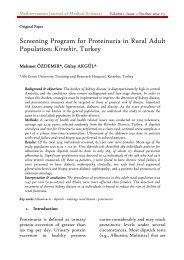Issues and Prospects of e-health in Pakistan
Background & objectives: In connection with access to information in developing countries, information flows through existing networks of communication is a main theme in the current IS literature . Methods:Information-intensive infrastructure is a requirement for information dissemination due to the shortage of network infrastructure in the majority of developing states. It is verified by many researchers that information managing technologies with their main purpose of ‘handling information’ have the advantage to enhance already existing technologies by making better information-communication a priori to new ICT innovations .Presently health information system infrastructure is deficient in resources to meet the demands and needs of increasing population in developing countries. Health care systems of developing countries have major barriers like poverty and lack of technological sophistication. Results:The basic difficulties or barriers in using information technologies include poor or inadequate infrastructure, insufficient access to the hardware and inadequate or poor resources allocation. By eliminating these barriers population health status can be improved in developing countries. Interpretation & conclusion: This study aims to determine the main issues and prospects for ehealth in the current situation of developing countries like Pakistan and the way forward for policy makers to manage all issues in future for more effective and rational decision-making in healthcare organizations. Key words: e-health; challenges; prospects; developing countries; Pakistan
Background & objectives: In connection with access to information in developing countries,
information flows through existing networks of communication is a main theme in the current
IS literature .
Methods:Information-intensive infrastructure is a requirement for information dissemination
due to the shortage of network infrastructure in the majority of developing states. It is
verified by many researchers that information managing technologies with their main purpose
of ‘handling information’ have the advantage to enhance already existing technologies by
making better information-communication a priori to new ICT innovations .Presently health
information system infrastructure is deficient in resources to meet the demands and needs of
increasing population in developing countries. Health care systems of developing countries
have major barriers like poverty and lack of technological sophistication.
Results:The basic difficulties or barriers in using information technologies include poor or
inadequate infrastructure, insufficient access to the hardware and inadequate or poor
resources allocation. By eliminating these barriers population health status can be improved in
developing countries.
Interpretation & conclusion: This study aims to determine the main issues and prospects for ehealth
in the current situation of developing countries like Pakistan and the way forward for
policy makers to manage all issues in future for more effective and rational decision-making
in healthcare organizations.
Key words: e-health; challenges; prospects; developing countries; Pakistan
Create successful ePaper yourself
Turn your PDF publications into a flip-book with our unique Google optimized e-Paper software.
Mediterranean Journal <strong>of</strong> Medical Sciences V1, I1 October 2014: 31-52 40<br />
are not well communicated.<br />
Secondly, people at higher<br />
positions <strong>and</strong> posts, whose needs<br />
<strong>of</strong> report<strong>in</strong>g are adequately be<strong>in</strong>g<br />
catered by the exist<strong>in</strong>g system, do<br />
not favor HIT as they th<strong>in</strong>k that<br />
the employment <strong>of</strong> new<br />
technology is wastage <strong>of</strong> both the<br />
money <strong>and</strong> time. Hospitals must<br />
address the apprehension <strong>of</strong><br />
physicians because if by us<strong>in</strong>g<br />
HIT their pr<strong>of</strong>essional<br />
responsibilities become difficult<br />
they will never support its use.<br />
4. Social <strong>and</strong> Cultural<br />
Barriers: Digital divide <strong>and</strong> e-<br />
read<strong>in</strong>ess are major social <strong>and</strong><br />
cultural barriers <strong>in</strong> establishment<br />
<strong>and</strong> use <strong>of</strong> <strong>health</strong> <strong>in</strong>formation<br />
system. These barriers <strong>in</strong>clude<br />
lack <strong>of</strong> stakeholder’s <strong>in</strong>terest, less<br />
motivation, anxiety to adapt <strong>and</strong><br />
use new technology. Health care<br />
personnel are difficult to conv<strong>in</strong>ce<br />
for use <strong>of</strong> new <strong>health</strong><br />
technologies. As they are more<br />
comfortable with their<br />
conventional approach <strong>and</strong><br />
rout<strong>in</strong>e practice so it is<br />
complicated to transform <strong>health</strong><br />
<strong>in</strong>formation system from paper<br />
based to digital format (Durrani et<br />
al., 2012).<br />
5. Infrastructure-related<br />
<strong>Issues</strong>: Most <strong>of</strong> underdeveloped<br />
countries do not have required<br />
technological <strong>in</strong>frastructure to<br />
establish national <strong>health</strong><br />
<strong>in</strong>formation system hence cannot<br />
promote HIT <strong>in</strong> private <strong>and</strong><br />
public hospitals. Reshap<strong>in</strong>g<br />
<strong>in</strong>frastructure <strong>of</strong> exist<strong>in</strong>g <strong>health</strong><br />
system is very crucial. Most<br />
develop<strong>in</strong>g countries do not have<br />
adequate required <strong>in</strong>frastructure<br />
such as computer hardware,<br />
s<strong>of</strong>tware, wired <strong>and</strong> wireless<br />
communication channels,<br />
Internet, <strong>and</strong> skilled pr<strong>of</strong>essional<br />
human resource. The availability<br />
<strong>and</strong> operation <strong>of</strong> these<br />
components <strong>of</strong> digital<br />
Infrastructure are necessary for<br />
establishment <strong>and</strong> promotion <strong>of</strong><br />
HIT <strong>in</strong> under developed<br />
countries. Strong <strong>in</strong>frastructure is<br />
required for the strong <strong>health</strong><br />
<strong>in</strong>formation system to improve<br />
exist<strong>in</strong>g <strong>health</strong> system by<br />
plann<strong>in</strong>g <strong>and</strong> <strong>in</strong>troduc<strong>in</strong>g new<br />
<strong>health</strong> care <strong>in</strong>terventions which<br />
results <strong>in</strong> achiev<strong>in</strong>g better <strong>health</strong><br />
goal. There are poor or <strong>in</strong>adequate<br />
resources allocation for<br />
implementation <strong>and</strong> use <strong>of</strong> the<br />
<strong>health</strong> technology <strong>in</strong> the<br />
develop<strong>in</strong>g countries.<br />
6. Hardware/S<strong>of</strong>tware: HIT<br />
requires specialized s<strong>of</strong>tware <strong>and</strong><br />
hardware to improve public <strong>health</strong><br />
by mak<strong>in</strong>g evidence based<br />
decisions. Often these s<strong>of</strong>tware<br />
<strong>and</strong> hardware tools are costly <strong>and</strong><br />
require sufficient tra<strong>in</strong><strong>in</strong>g for<br />
proper operation.<br />
7. Poor Availability <strong>of</strong><br />
Internet: Poor <strong>in</strong>ternet availability<br />
is a vital <strong>in</strong>frastructure barrier.<br />
Health care specialists have poor<br />
access to real time <strong>in</strong>formation<br />
©2014 Mediterranean Center <strong>of</strong> Medical Sciences








